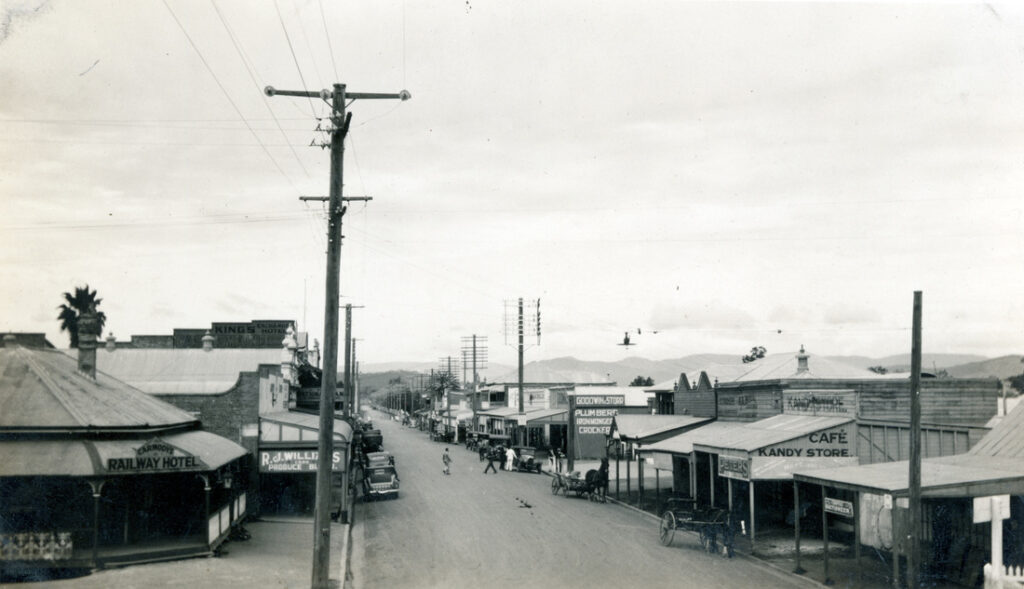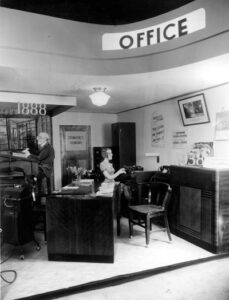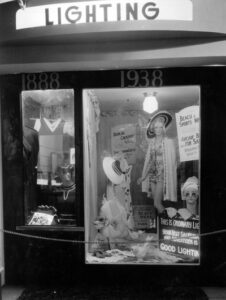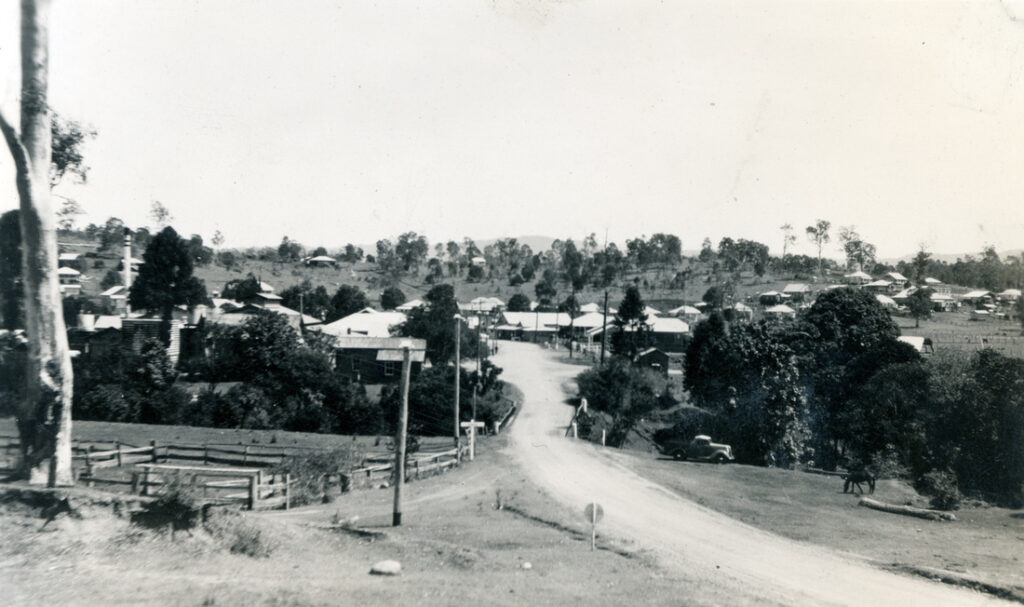1930’s Electric Memories
During the 1930s, it became evident that a complicated situation had developed in Queensland, which if not addressed, could affect the development of electricity supply throughout the state.
In December 1935, South East Queensland, covering only 2.86 per cent of Queensland, contained 56.17 per cent of the State’s population. In actual numbers, that was 554,871 people living in South East Queensland out of a total 970,719. Furthermore, it was found that out of 152,000,000 units of energy, which had been generated in Queensland that year, 122,000,000 units were generated for people in South East Queensland.


1930
In March, 1930, IESCo obtained Orders-in-Council for the shires of Rosewood, Esk, Laidley and Tarampa. The company supplied farms en route and the towns of Marburg, Rosewood, Lowood, Laidley, Forest Hill, Gatton, Grantham, Esk and Toogoolawah. By mid-1933 the reticulation of the Lockyer Valley was complete.
Mr Horace Gartside worked with his grandfather for a while after leaving school and before starting as an electrical labourer in Gatton in 1939. His grandfather did various jobs for IESCo and allowed one of the IESCo construction gangs to use a building he owned ‘as a store and a camping place for some of the gang who were a sort of mobile workforce’. He said that the gang reticulated the township of Laidley very quickly and then went on to other areas.
One of Horace’s prominent memories was
the building of a line between Gatton and Grantham… A gang was formed to build this line because the steam engine at the Grantham Butter Factory had collapsed and was unable to be used any longer and they decided to put in a large electric motor, which in those days was a very big load in a rural area…
As with the reticulation of Laidley town, the Gatton to Grantham line was built quickly. Horace said that the gang worked day and night for five days and five nights to finish the line. It was not an easy task and all the pole holes had to be dug out by hand. The engineer in charge of the construction gang gave verbal encouragement to the men and allowed them some beers before breakfast ‘on the organisation’ each day. Horace and his grandfather supplied poles for the first rural extension, mainly for irrigation purposes, to the head of Laidley Creek. He recalled that there was plenty of competition between tractor and diesel engine suppliers, and IESCo who wanted to sell electric motors.
My Grandfather and I had the first ever outdoor display of domestic electrical appliances and a working electric motor and irrigation pumping from and into the Laidley Creek at the Laidley Showgrounds in 1934.
Continuing with his reminiscences, Horace talked about the trees used for poles and the building of the lines.
The poles we supplied for the Laidley to Thornton extension … had to be the narrow leafed grey ironbark poles and they had to be dressed, in other words the sap had to be removed and it had to be dressed down to the hard wood…
Mr. McCullogh, who was the Chief Engineer, had worked out a plan of building what he called backbone feeders into areas which would assist in the reticulation. ..they would build the 11 kV line and a 33 kV to supply it into the area and from that they would run reticulation lines to various farming areas and various communities which would provide electricity for irrigation, which was a very big load in those days. It was a very big commercial load…
1930: Clermont
The Belyando Shire Council inaugurated supply for Clermont in November, 1930. There were 228 consumers out of the population of around 2,000 in the supply area by 1938. The Engineer and Manager at that time was Mr. P.J. Whear.
Pine, Cleveland, Tingalpa, Beenleigh, Coomera, Tamborine and Waterford
In 1930, CEL successfully applied for Orders-in-Council for the shires of Pine, Cleveland, Tingalpa, Beenleigh and Coomera. Tamborine and Waterford were added soon after. Transmission lines were constructed to take power to Wellington Point, Cleveland and Victoria Point in the bay area and south to Beenleigh, Coomera, Tamborine and Eagle Heights, with the latter two towns getting an electricity supply on 23 December, 1933, just in time for Christmas. Lines were also constructed to Canungra. Small towns along the track of the main transmission lines were linked to supply and gradually the network began to spread to the outlying farms.




1930: Barron Falls Scheme in the Far North
An Order-in-Council dated 19 March, 1930, led to the creation of the Barron Falls Hydro-Electricity Board. There were nine members on the original Board, including six representatives from Cairns City Council and three representatives from Cairns Shire Council. The area of supply was registered as being the city of Cairns, Cairns Shire and a small section of Woothakata Shire at Kuranda. The main aim of the Barron Falls Hydro-Electricity Board was to initiate a hydro-electricity scheme to supply the whole of the Cairns area as far as Gordonvale.
Work on the hydro station began on 28 July, 1932 and was completed by the end of 1935. The Barron River was used to generate electricity for the first time in November 1935. The Powerhouse contained three turbo-alternators of 1320kW capacity each. The plant did not exploit the full potential of the Barron River. It was successful up to a point. Its main shortfall was that the design of the Powerhouse did not offer much of an opportunity to extend when it became necessary to upgrade the existing plant to meet the growing demand for electricity in North Queensland.
The powerhouse, the first in Australia to be built underground, was located on the left bank of the river immediately below the main Barron Falls.
When giving evidence to the Royal Commission in 1936, Mr. Collins pointed out that the Barron Falls scheme could not have been successfully undertaken if it had not been for the ‘profitably operated electrical undertaking’ in existence in Cairns at the time. Apart from financial considerations, the Cairns Powerhouse supplied the current for hammer and drill work in the tunnel, excavations and lights, and the services of trained staff. The Barron Falls Hydro-Electricity Board was able to use, in emergencies, steam-driven plant at the Cairns Powerhouse, oil-driven plant at the Atherton Powerhouse and had an arrangement to utilise the 75kW plant at the Mulgrave Central Sugar Mill at Gordonvale if necessary.
Charters Towers: 1930/31
The Charters Towers Electricity Supply Company, first known as the North Australian Worsted and Woollen Mills (Charters Towers) Ltd convened the first meeting on 3 May, 1924. At the annual meeting of the Directors on 31 January, 1930, a plan to start an electricity scheme was brought up. Following discussions, an application for an Order-in-Council was made and the Order was granted to Charters Towers in1931. Mr. R. Clarke was appointed as the first Manager and electricity had been supplied to the town since that time.
1931: Killarney
Killarney Electric Light Company Ltd was inaugurated in October, 1931 and supplied Killarney and Tannymorel. By 1940, supply was also provided for Spring Creek. There were 314 consumers out of 1,600 in the supply area.
1933: Nanango
Nanango is one of the oldest country towns in Queensland and it was the third town in the South Burnett to have electricity. After a period of deliberation and discussions, the Nanango Butter Factory generated electricity for the town in 1933. It was in 1929 that the Nanango Chamber of Commerce, not for the first time, raised the issue of an electric light scheme for Nanango.
An application for an Order-in-Council was submitted and on 28 July, 1932, the order was granted authorising the council to supply electricity. A loan of 2,500 pounds was granted to the council by the Treasurer to enable the council to defray the initial cost of installation.
To celebrate the first time that Nanango town had electricity, on 23 March, 1933, there was a ‘Switching-on Ceremony’ with a gala ball, a racing carnival and other festivities. Around 2,000 people attended, many travelling long distances to watch the lights go on in Nanango. The plans for the ceremony appeared in the local newspaper in February, 1933. The Nanango News reported that there would be a weekend of festivities with a Grand Ball, a boxing tournament, horse racing and ‘The Big Event Itself’.
‘The Big Drive’ on the night of the switching on of the Electric Light in Nanango, will meet with the approval of residents is… The festivities include a Grand Ball for Friday, March 24, Boxing contests on Saturday morning, Racing on Saturday afternoon and the ceremony of Switching-on at night. The streets will be gaily decorated and it is anticipated that three bands will be playing in the streets and a concert party will also brighten the proceedings. Numerous stalls will be erected and a wonderful night’s entertainment is promised. A Public Holiday will be declared and business premises are being requested to close at 10.15 a.m.
A dinner was held at the Palace Hotel in Nanango for the dignitaries attending the ceremony. With vegetable soup or beef tea for the first course, a choice of steak and kidney pie, roast turkey, duck, pork, lamb, beef, York ham or corn mutton and traditional accompaniments for the main course, plum pudding with custard, fruit and baked custard, fruit salad or jelly with cream or seasonal fresh fruit for dessert, it was a meal claimed to reflect the importance of the occasion. The local newspaper stated that the electricity switch-on was Nanango’s ‘…Greatest Achievement In Its History’.
That Nanango can enter into, with enthusiasm, the celebration of the greatest event of its history was proved on Friday and Saturday when the switching on of electric light festivities were held and the actual switching-on ceremony was performed by the Minister for Mines (The Hon. Jas. Stopford, M.L.A.) Even the most optimistic person would never have anticipated such a tremendous crowd that patrolled Drayton Street on Saturday night, for giving a low estimate, about 2,000 people were present, many of whom travelled long distances to be present, and when the Minister pressed the button and Nanango actually had light, the pent up feelings of the gathering were released in an outburst of cheering never equalled before. There is no question that the people of Australia always give credit where credit is due, for when three cheers were called for, Mr. D. Casey, by whose untiring energy and loyalty to his town and district has resulted in this epoch of advancement, the call was responded to in a manner which showed their appreciation and confidence in him.
Immediately following the official dinner, the party moved to the front of the Post Office Hotel where the switch had been placed for the public ceremony. A ‘motor lorry’ had been used to provide a raised platform for the Hon. J. Stopford to perform the switch on for Nanango residents. A council representative announced that the number of consumers would rise from the initial 70 to 90 to around 120 when the benefits of electricity were witnessed.
One year on from the switching-on ceremony, the forecast for the number of consumers proved to be a conservative estimate with the total number of consumers after twelve months standing at 150. Cr. McClymont, Chairman of Nanango Shire Council, considered that the electric light scheme was working satisfactorily and was optimistic that given the rate of progress already witnessed that the scheme would soon pay its way. Noting the progress over the last year, Mr. Casey, Chairman of the Nanango Chamber of Commerce, the group that first placed the scheme for electricity to the local council and the butter factory, remarked
I wonder would any local resident like to have the electric light withdrawn after having its convenience for a year? I am sure not.
Startled by ‘shrill whistles’ coming from the powerhouse at 8.30pm on a Sunday night in March, 1934, residents of Nanango started to run, or drive in their vehicles, to the Powerhouse at the Butter Factory expecting a tragedy to have occurred. The engineer, Mr. O’Shea seemed to be more surprised than the concerned residents when he saw the gathered crowd. He had remembered the anniversary of the coming of electricity to Nanango twelve months before, on 25 March, 1933 and had sounded the whistle to commemorate the momentous occasion. The whistle blasts certainly brought back some memories of that night when 2,000 thronged the streets of Nanango.
1933: Wondai
Wondai was not far behind Nanango for a Switch-on Ceremony. The extensive saw mills, joinery and cabinet works owned by Mr. F.H. Jones became the vehicle to provide electrical energy for Wondai. It was an exciting time for Wondai residents when the local council formulated a contract for the supply of electricity to the town with Mr Jones. Power was already available from a huge 90hp suction gas engine for the heavy day load of the mill and electricity, with a 45hp engine for lighter loads.
The installation in connection with the contract for supply of electricity to the Shire Council comprises two three-phase 50-cycle alternators, one 60 kW and one 20 kW, voltage 415-250, with a very fine switchboard.
The large engine was tested by an expert and it was found that 150 amps were generated when the demand for Wondai residents for lighting and power was 25 amps. The press claimed that Mr. Jones’ enterprise would be profitable to Mr. Jones and would be a boon for the town considering that all the advantages of electricity would be provided at a comparatively nominal rate to ratepayers.
The Switch-on Ceremony was performed by the Hon. Mr. J.B. Edwards, M.L.A., on Friday night, 25 August 1933. Speaking from the darkness, the Chairman of the Wondai Shire Council, Cr. Outridge said that he was pleased with the number of people that had turned out for the occasion. It had taken three years for the result of the negotiations to be witnessed by the people of Wondai. Cr. Outridge briefly outlined the history of the transactions for an electricity supply. First of all there had been plans to install power plant at the Wondai Butter Factor. That had fallen through. The Gympie Electric Light Authority had put in a proposal and later withdrawn. Then there was the proposition for power to come to Wondai from the Murgon Power House, and around the same time, Mr. Jones had been approached by the council. The latter seemed to be a more viable and economic proposition. The Government granted the necessary Order-in-Council and Wondai Shire Council were able to go ahead with the agreement with Mr. Jones.
Wondai town and district should be grateful to Mr. Jones for his fine display of local patriotism as evidenced by the heavy expenditure entailed in the erection of his power house, which enabled the Wondai Shire Council to install one of the cheapest electricity schemes in the State…
It was announced that the Wondai electricity scheme had 100 consumers ready to have power. It was anticipated that the number would rise to around 200 in the near future. Mr. Edwards said that it was his pleasant duty ‘to bring Wondai out of the darkness into the light’. He continued to say that it would be a great forward step for the town and one which would increase the comfort of the residents, since electricity could be put to so many different uses in the home. Country people, he said, deserved the comforts available to their city cousins. Punctually at 6.45pm outside the Shire Office, Mr. Edwards
touched the button and the whole township presented an animated appearance of brilliance and beauty… Never before in its record had Wondai shed such an illuminous ray of light over its people.
The switch-on was accompanied by loud cheering from the crowd outside Wondai’s Council Office, a long blast from the timber mill whistle and blasts from car horns. Selections played by the Wondai Town Band sounded forth as the crowd dispersed to attend the functions put on for the occasion. The Mondure Hotel was the venue for the official dinner while the Memorial Hall in Wondai and the Oddfellows’ Hall were becoming packed to capacity.
The ‘Electric Ball’ was held in the evening in the Memorial Hall. Beautiful decorations adorned the ceiling and the tables were decorated with Iceland poppies and sweet peas. Six huge hoops were suspended from the ceiling and decorated with coloured steamers and Chinese Lanterns containing electric light bulbs. The stage was transformed to look like a pergola with an arch, which was festooned with bougainvillea and baskets of flowers. The decorative4 work was carried out by Messrs. P.P. O’Brien and N.L. Anderson. There were four sittings in the Supper Room, with the people attended by the Queensland Country Women’s Association (QCWA) ladies from the Wondai Branch under the supervision of Matron Drinkwater.
1933: Allora
Allora Shire Council was inaugurated in 1933 and supplied the town with electricity purchased in bulk from the Warwick Dairy Association’s Butter Factory at Allora. By 1940 there were 186 consumers out of a population in the supply area of 2,600.
1935
Information leaflets offering advice on tariffs were distributed by City Electric Light Company (CEL) as a customer service. In 1935, the Assistant Manager reported that around 10,000 were given out at the Royal National Agricultural and Industrial Association’s (RNA) Exhibition, or Show, known as the ‘Ekka’ in the month of August. During the RNA’s Show, ‘moving pictures’ of the activities of CEL and the Ipswich Electric Supply Company were shown ‘continuously day and night’. The themes in the film covered ‘Domestic, Lighting and Industrial Power and Heating used in city and suburban houses, shops and factories’ in Brisbane and rural regions. There was a domestic display with electrical appliances and an industrial power display included pumps, machinery and soil heating equipment. CEL continued to set up displays at the Ekka in the late 1930s.
1936
When a Royal Commission was appointed by the Queensland Government in 1936 to examine the state of the electricity industry in Queensland, the objective was to obtain a comprehensive recommendation for the future development of Queensland’s electricity industry. In its report, the Commission recorded that Queensland’s electrical development was slower than some other states in Australia and agreed that extension of electricity reticulation was urgently needed.
It was emphasised that an electricity supply
was one of the best agencies in arresting the drift to the cities, spurring the land-holder to his best efforts because it makes his work less laborious and more lucrative and his family’s surroundings more congenial.
The Commission’s investigations began in Brisbane on 10 March, 1936. Between then and its final sitting on 12 October, 1936, the Commission had heard evidence from 25 other towns and shires in South East, Central and North Queensland. The largest submission of evidence came from the City Electric Light Company (CEL), which was the successor of Edward Barton’s Brisbane Electric Supply Company and based in Brisbane. The CEL supplied power to a wide area of South East Queensland and had plans for further expansion.
Mr. E.S. Cornwall, who was the Assistant Manager of CEL and the Consulting Engineer for IESCo in 1936, noted that
in the towns a comparatively small percentage of the houses are connected as consumers and the average consumption is low, but that the average farm connected uses a comparatively large amount of electricity. As the advantages of electricity become more appreciated on farms, we anticipate both that a greater number of farms will be connected with our mains and that a greater consumption of electricity will result.

1936: Extensions to Supply to Mount Cotton, Bethania, Pimpama, Ormeau, Kingston, Dayboro and Samford
Extensions were approved for supply to Mount Cotton, Bethania, Pimpama, Ormeau, Kingston, Dayboro and Samford in 1936. The supply to Mt. Cotton was planned to come from CEL’s South Coast transmission line near Redland Bay via a 5kV branch line, three pole-top stations and low tension distribution lines to poles, which were supplied and erected by the residents. They also contributed to the cost of the work by doing some of the clearing. The South Coast was a rapidly-developing area and demand was growing considerably. Further demand would necessitate the conversion of the 5kV transmission lines to 33kV, at least for some of the route. The number of rural consumers increased substantially from 1933, with 324 consumers to 1936 with 899. The highest percentage increase was in 1935.
Dayboro and Samford in Pine Shire received power from CEL in 1936, with Dayboro on 12 September and Samford in December of the same year. The connection to Dayboro was switched on by CEL at 2.30pm so that 30 of the residents could enjoy their first night with electricity. The first public function to be held with electric light in Dayboro was the annual Dayboro Rifle Club Smoke Concert that same evening.
A saw mill and a flour mill in Lawnton had requested power in 1935 and a temporary supply was accessed from the 33kV Redcliffe line until adequate voltage conversion was in place for the area. The outbreak of the Second World War saw the progress of rural electrification placed in a hesitant phase and the rest of Pine Shire residents had to be patient for their turn to receive power.
